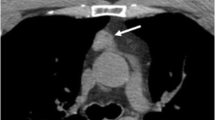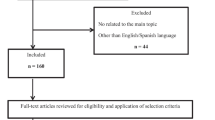Abstract
The ectopic ACTH syndrome (EAS) caused by thymic carcinoid is rare and its diagnosis remains a challenge to the endocrinologist. Here are six cases of EAS with a typical Cushing habitus accompanied by hyperpigmentation and hypokalemia. For all six patients, the high dose (8 mg) dexamethasone suppression test (HDDST) showed lack of suppression, computed tomography (CT) scanning documented anterior mediastinal masses, and the mediastenal tumors removed were confirmed as ACTH secreting thymic carcinoids by positive ACTH and NSE staining. Our data indicate that HDDST chest radiologic imaging and other laboratory examinations will greatly assist in diagnosing the thymic carcinoid-induced EAS at an earlier stage, which will significantly improve the long-term survival of the patient.
Similar content being viewed by others
References
Beuschlein F, Hammer GD. Ectopicpro-opiomelanocortin syndrome. Endocrinol Metab Clin North Am 2002, 31: 191–234.
Lu Z., Cuo A, Zhang J. Diagnosis and treatment of 20 cases of ectopic ACTH syndrome (chinese). Chinese J Endocrinol Metab 1999, 15: 331–4.
Garcia Puente I, Sanchez Moro V, de Pablos Velasco P. “Occult” ectopic ACTH secretion syndrome: a case report. An Med Interna 2000, 17: 595–6.
de Perrot M, Spiliopoulos A, Fischer S. Neuroendocrine carcinoma (carcinoid) of the thymus associated with Cushing’s syndrome. Ann Thorac Surg 2002, 73: 675–81.
Davies CJ, Joplin GF, Welbourn RB. Surgical management of the ectopic ACTH syndrome. Ann Surg 1982, 196: 246–58.
Findling JW, Tyrrell JB. Occult ectopic secretion of corticotropin. Arch Intern Med 1986, 146: 929–33.
Newell-Price J, Trainer P, Besser M, Grossman A. The diagnosis and differential diagnosis of Cushing’s syndrome and pseudo-Cushing’s states. Endocr Rev 1998, 19: 647–72.
Landolt AM, Schubiger O, Maurer R, Girard J. The value of inferior petrosal sinus sampling in diagnosis and treatment of Cushing’s disease. Clin Endocrinol (Oxf) 1994, 40: 485–92.
Imai T, Kikumori T, Funahashi H. Surgical management of Cushing’s syndrome. Biomed Pharmacother 2000, 54: 140s–5s.
Grossman AB, Howlett TA, Perry L, et al. CRF in the differential diagnosis of Cushing’s syndrome: a comparison with the dexamethasone suppression test. Clin Endocrinol (Oxf) 1988, 29: 167–78.
Oldfield EH, Doppman JL, Nieman LK, et al. Petrosal sinus sampling with and without corticotropin-releasing hormone for the differential diagnosis of Cushing’s syndrome. N Engl J Med 1991, 325: 897–905. Erratum in: N Engl J Med 1992, 326: 1172.
de Herder WW, Uitterlinden P, Pieterman H, et al. Pituitary tumour localization in patients with Cushing’s disease by magnetic resonance imaging. Is there a place for petrosal sinus sampling? Clin Endocrinol (Oxf) 1994, 40: 87–92.
Hall WA, Luciano MG, Doppman JL, Patronas NJ, Oldfield EH. Pituitary magnetic resonance imaging in normal human volunteers: occult adenomas in the general population. Ann Intern Med 1994, 120: 817–20.
Tabarin A, Valli N, Chanson P, et al. Usefulness of somatostatin receptor scintigraphy in patients with occult ectopic adrenocorticotropin syndrome. J Clin Endocrinol Metab 1999, 84: 193–202.
Torpy DJ, Chen CC, Mullen N, et al. Lack of utility of (111)Inpentetreotide scintigraphy in localizing ectopic ACTH producing tumors: follow-up of 18 patients. J Clin Endocrinol Metab 1999, 84: 1186–92.
Biering H, Pirlich M, Bauditz J, Sandrock D, Lochs H, Gerl H. PET scan in occult ectopic ACTH syndrome: a useful tool? Clin Endocrinol (Oxf) 2003, 59: 404–5.
Price J, Kruseman AC, Doniach I, Howlett TA, Besser GM, Rees LH. Bombesin-like peptides in human endocrine tumors: quantitation, biochemical characterization, and secretion. J Clin Endocrinol Metab 1985, 60: 1097–103.
Doppman JL, Pass HI, Nieman LK, etal. Corticotropin-secreting carcinoid tumors of the thymus: diagnostic unreliability of thymic venous sampling. Radiology. 1992, 184: 71–4.
Imai T, Kikumori T, Funahashi H, Nakao A. Surgical management of Cushing’s syndrome. Biomed Pharmacother 2000, 54 (Suppl 1): 140S–5S.
Author information
Authors and Affiliations
Corresponding author
Rights and permissions
About this article
Cite this article
Wang, W.Q., Ye, L., Bi, Y.F. et al. Six cases of ectopic ACTH syndrome caused by thymic carcinoid. J Endocrinol Invest 29, 293–297 (2006). https://doi.org/10.1007/BF03344098
Accepted:
Published:
Issue Date:
DOI: https://doi.org/10.1007/BF03344098




